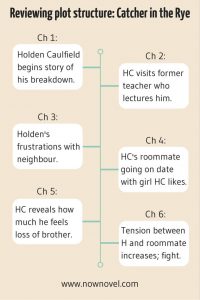Plot weaknesses can derail a story and leave readers feeling unfulfilled and frustrated. Plot holes, unexplained departures from the established rules of your fictional world and other quirks can ruin a promising book. Here are 7 don’ts for how to plot a novel:
1: Don’t create plot holes
In novels, plot holes are gaps or logical inconsistencies in narrative that disrupt the logical progression established by the novel’s plot. Events or statements that contradict earlier events or statements in the story fall under this category.
For example, in sci-fi/fantasy involving time travel, a protagonist can’t go back in time to prevent an antagonist/villain from being born. The earlier removal of the villain would negate any need for future time travel in the first place (a classic time travel paradox).
Famous examples of plot holes in fiction include a little-known error in the first UK edition of Harry Potter and the Philosopher’s Stone by J.K. Rowling. On page 56, a witch (a minor character) complains about the price of an item being ’seventeen Sickles’ yet in the monetary system of Rowling’s world there are seventeen Sickles to a Galleon. The witch would thus more likely say ‘one Galleon’. Although this is a very minor oversight, the inconsistency was changed for subsequent editions.
To avoid creating plot holes in your own fiction:
- Get feedback from readers and a skilled editor who can see your arcs as a whole
- Keep a document of ‘true’ facts for each character, mythical creature or item of invented technology. Whenever you bring said element into a scene you can scan through established facts and resulting key points and impossibilities
- Keep your novel's plot as clear as possible. The more conceptual or technical your ideas become, the higher the risk of plot holes
2: Don’t neglect to create character arcs alongside novel plot arcs
Focusing on plot development to the exclusion of character development can result in characters who read as static and even boring. A good plot shows not only interesting turns in events but how they affect characters, their psychologies and choices.
An example: In the Russian author Fyodor Dostoevsky’s classic novel Crime and Punishment, early in the novel the anti-hero Raskolnikov decides to kill a mean and unscrupulous pawnbroker. There is an unexpected turn in the execution of the murder that worsens an already-terrible act and heightens Raskolnikov’s sense of torment. Plot development and character development go hand in hand, making consistent sense.
3: Don’t leap into novel plotting without a sound grasp of plot structure
If you’re plotting a novel (particularly if it’s your first attempt), start from a sound understanding of good plot structure. As an exercise, take a book you’ve recently read and summarize core plot events. Place the major plot events of each chapter on a timeline. The end result might look something like this example, the first 6 chapters of JD Salinger’s Catcher in the Rye:

Note core structural details. For example, Salinger introduces the idea that the 16-year-old is troubled at the start of the story, but delays revealing a pivotal factor of his breakdown. Salinger delays revealing the sad backstory involving Caulfield's brother Allie until the fifth chapter. The author also shows various other pressures (a demanding and rigid education system; complicated peer relationships). These subplots support the broader plot arc of Holden’s breakdown, explaining the multiple pressures that contribute.
Analyzing the plot structures of effective stories will help you to avoid making common structural plot mistakes.
4: Don’t forget to include the 5 W’s
The 5 W’s – ‘who’, ‘what’, ‘why’, ‘where’ and ‘when’ – are crucial to any story. Your plot needs to give the reader a clear sense of who the story is about. What significant events happen to them? Why do the story's core events happen, and why do characters respond to them as they do? Where do events play out, and when does it all take place ? The time-frame of the story's events as well as the broader era in which the story is set should be clear.
The weight you give each of the 5 W’s, however, may depend on your genre. A historical romance, for example, will naturally detail the 'when' of the story more than a contemporary romance that is less concerned with period and establishing a sense of historical realism. Even so, if you neglect to include one or more of the 5 W’s in the course of your story, it could feel a little hollow.
5: Don’t flout your own fictional world’s rules without good reason
The beauty of writing fiction is that you get to set the rules for your fictional world. In Gabriel Garcia Marquez’s One Hundred Years of Solitude, a girl is so thin from not eating because she cannot see the man she loves that she flies into the air when hit by an updraft while shaking out a sheet. This magical, odd event is allowed in Marquez’s world, where the magical and unexpected can and do happen.
In your own writing, make sure that your plot does not take sudden turns that depart from the established rules of your world. If you are writing a realist novel, in which there is no hint of magic until Chapter 10, a character taking supernatural flight is a risky plot move. At best, it could divide readers, some of whom might feel you’ve ‘lost’ the plot. At worst your book could be deemed bad due to narrative inconsistency.
If you will disobey the fictional rules you establish throughout your novel (such as the usual laws of physics), make sure you have a justifiable reason to do so.
Writing novel subplots is also rife with pitfalls:
6: Don’t include novel subplots that don’t support your main story arcs
Subplots are useful for many reasons. A good subplot:
- Breaks up the monotony of a main plotline with its core character goals
- Gives you the opportunity to introduce interesting secondary characters who will be crucial to the action of your novel going forwards
- Supports and enhances the reader’s understanding of your main story arcs
The third point is especially vital. If you pepper your narrative with subplots that don’t propel the story towards its resolution in any way, this can slacken pace. The distraction can make the narrative start to feel wandering and aimless.
An example of the good type of subplot: In Dostoyevsky’s Crime and Punishment, early in the novel Raskolnikov learns, via a letter from his mother, that his sister Dounia plans to marry a man she does not love for financial security. This despite the man seeming miserly and conservative in his views of wifely 'duty'. Raskolnikov's mother suggests that Dounia will marry simply to ease her brother’s finances and help him secure work in the long term through her future husband.
Raskolnikov abhors the idea of the match. The subplot of Dounia’s marriage proposal in Crime and Punishment builds the sense of desperation that drives Raskolnikov to kill for money. Similarly, prioritize subplots that increase narrative suspense and tension and propel your story towards approaching developments in your main characters’ arcs.
7: Don’t let an outline dictate your novel’s plot rigidly – use it flexibly

Novel plot outlines are extremely useful for giving your story a clear sense of direction and purpose. As John Gardner said, ‘Writing a novel is like heading out over the open sea in a small boat. It helps if you have a plan and a course laid out.’ At the same time, you need to be prepared for sea changes, so to speak.
If you stick to your outline doggedly, you might ignore places where deviation would make sense. Your outline might say your story should go in one direction while your characters (your gut creative intuition) are telling you to go in another. It’s thus important to treat your outline as a navigational guide – this way you can chart the entire course of your novel while still allowing for sensible detours. Use Now Novel’s idea finder to create a blueprint for your novel. When you're done, you can use your outline flexibly in this way.
Are you in the novel plotting stages? What do you find most challenging about plotting a book?









What I find most challenging in plotting a book is making it believable. The reader has to be able to say, 'that could happen.'
Tami - Over 8 years ago
This is true, Tami. Especially for fantasy and other fantastical genres where we're asked to suspend disbelief - the task becomes making x fantastical event believable for the fictional world in particular.
Bridget At Now Novel - Over 8 years ago
I have trouble filling in all the plot holes. There's a certain amount of scheming in my plots, and I struggle to ask and answer all the possible "but why didn't he just...?" questions.
A.S. Akkalon - Over 8 years ago
That's where having a really good editor comes in handy, A.S. Also, sometimes readers will ask 'but why didn't he/she just...' regardless of whether there are actual plot holes (they simply think the story could/should have taken a different turn).
Bridget At Now Novel - Over 8 years ago
Brilliant advice
Marissa - Almost 8 years ago
Thanks, Marissa!
Bridget At Now Novel - Almost 8 years ago
This is a late reply but I just wanted to say that the thing I find most challenging about plotting my story is rewriting. I'm currently in the process of creating a new plot and I feel lots of pressure to make my story better to avoid making the same mistakes.
Marissa - Over 7 years ago